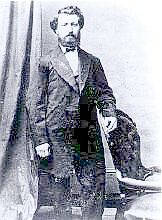
The M�tis
The term M�tis, like the 'mestizo', has its origins in the Latin word 'mixticius' which means a person of mixed racial ancestry. M�tis, however, describes more than race�it refers to a culture and a nation that played a significant role in the history of the Canadian West and is now a proud part of the Canadian mosaic. A Canadian led two uprisings against the Canadian government in 1869 and 1885. Before the uprisings the Dominion of Canada had bought the Northwest Territories from the Hudson�s Bay Company, and started to open territories to settlers from the east. The métis, French and English half-breeds who occupied part of those lands, felt they were being dispossessed. Riel, who followed his father as leader of the métis, protested in vain. An armed revolt broke out against the Dominion government in 1869. The rebellion failed. Riel asked vainly for amnesty which had been verbally promised and fled to the United States. He remained there for several years. He was elected to the House of Commons in 1873 and 1874, but was denied his seat and declared an outlaw in 1875. In 1877, Riel was held for a time in an insane asylum in Quebec, but soon he was free again. He lived in Montana for five years. During these years, hundreds of métis left their Red River homes and moved westward on the Saskatchewan River. They called Riel to help them because they again feared that they would be dispossessed. Riel was elected president of a short-lived provisional government. Another uprising , with Indian support, broke out in 1885. Riel surrendered, and was found guilty of high treason. He was hanged on Nov. 16 1885. His hanging caused a wave of religious and racial hatred that swept across Canada and had far reaching political effects. Riel was born in St. Boniface, Manitoba. He was educated at Montreal College Red River Rebellion, or First Riel Rebellion, occurred when the settlers in the Red River Valley of Manitoba revolted against the Canadian government in 1869-1870. This uprising was called the Red River Rebellion. Most of the rebels were half-breeds, or métis, who opposed the extension of British rule into a region that had long been almost independent. The Hudson Bay Company had ruled the Red River Valley until 1869. It allowed the métis to live musc as they pleased. But in 1869, the company turned its rights to Rupert�s Land (including present day Manitoba) over the British government. In 1870, Great Britain gave the district to the Canadian government, and plans were drawn up for developing the region. At this time, the only people that lived in the Great Northwest were Indians, a few traders, and about 12,000 Red River Valley settlers. These settlers lived a simple life. They held no title to the lands they farmed. When they grew tired of a plot of ground, they moved on to some other spot which suited them.
The RevoltRoad builders, surveyors, and officials of all kinds suddenly descended upon the settlers. Their lands had been arranged on the old French plan of strips reaching back from the river fronts. The new officials decided to rearrange the farms into townships & sections. This alarmed and angered the settlers and caused great excitements A leader arose among the métis. He was Louis Riel, a settler of French, Irish, and Indian Blood. The Canadian government soon sent out William McDougall as the first governor of the new territory. When Riel heard of McDougall�s approach, he determined to keep him from organizing the new government. Riel led the métis in an attack on Fort Garry, now the city of Winnipeg. They captured the fort, and Riel set up a "provisional government" there. The settlers prepared to resist authority of the Canadian government. The métis met McDougall at the border of Rupert�s Land, and forced him to turn back. McDougall wisely saw that the métis had a real grievance. He obeyed Riel, in order to keep the peace. But at this point Riel lost his head and doomed the rebellion. A group of loyalists made an attack on the metis at Fort Garry. The rebels drove the loyalists off and captured some of them. Riel imprisoned the captives as "enemies of the provisional government". A young English Canadian named Thomas Scott was one of those imprisoned. For some reason, the métis picked Scott. As an example. They condemned him as a traitor to the "provisional government" and shot him. Riel�s FlightThe people of Eastern Canada became extremely indignant at this cold blooded murder. A force of 700 men , under the command of Colonel Garnet Wolseley, was ordered into the Red River Valley. They made the long, difficult journey westward by way of Lake Superior. As they approached Fort Garry , Riel fled into the United States. His flight from the Red River Valley ended the rebellion. While Wolseley and his men were marching westward, the Dominion Parliament admitted Manitoba as a self governing Province of the confederation. The government set aside 1,400,000 acres for the use of the métis. But many of them were still dissatisfied and wandered westward into the present province of Saskatchewan. Riel also appeared in that territory some years later, and led another revolt as the Saskatchewan Rebellion.
|
